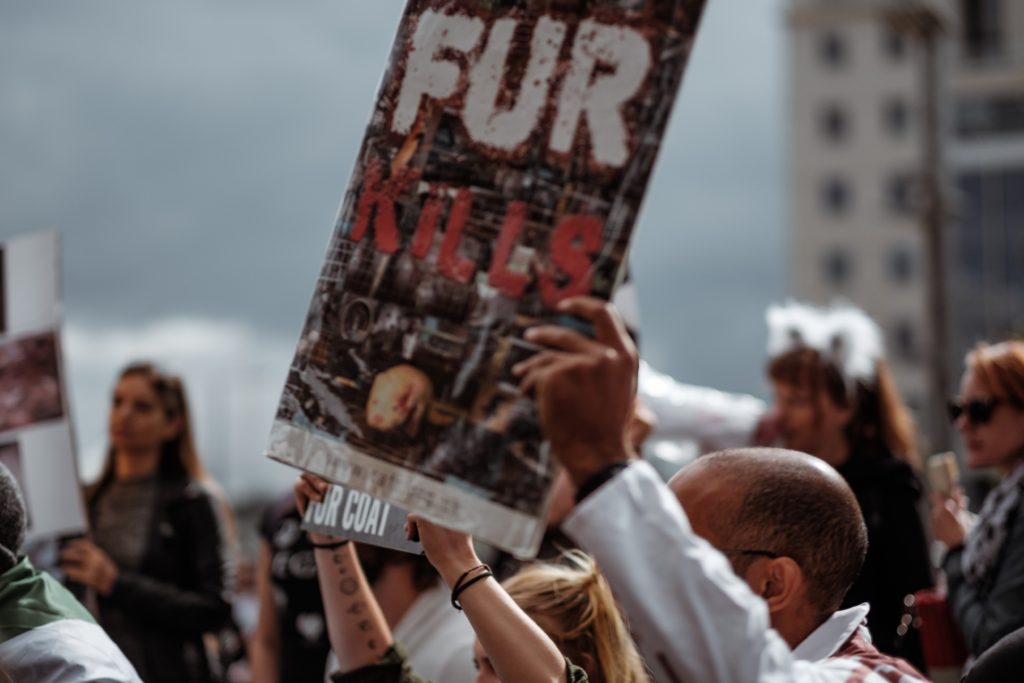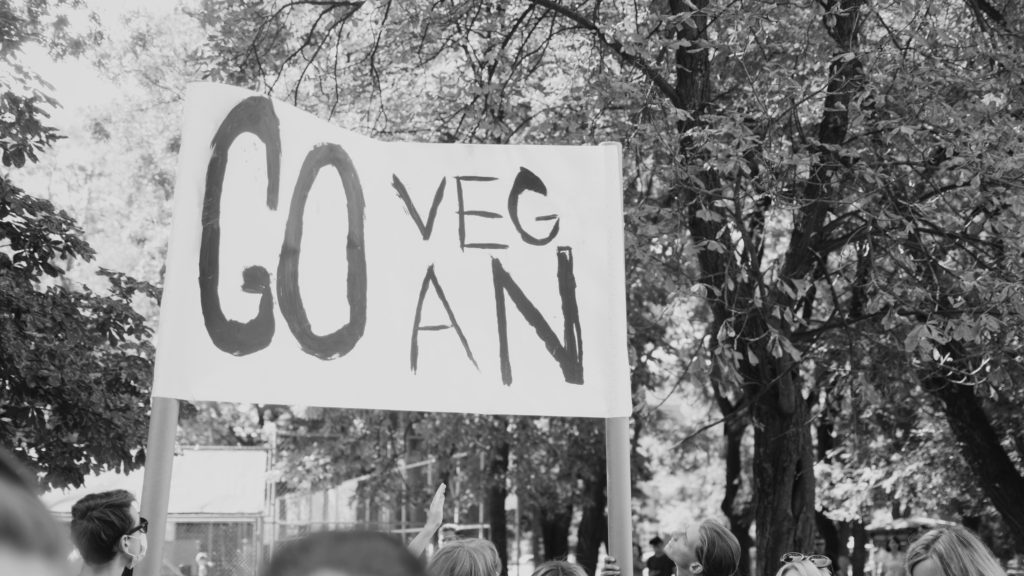Thunberg was named 2019 Person of the Year by TIME magazine, a distinction awarded for a person who “for better or for worse… has done the most to influence the events of the year.” Thunberg’s influence has been viral. In March of 2019, 1.7 million students in 120 countries went on strike from school to demand climate action from their governments. In September, that number increased to over four million. With Thunberg’s involvement, the sidelined and too-often-denied issue of climate change captured the full attention of the mainstream media. Thunberg achieves sweeping impact by unabashedly utilizing generational guilt, living a low-carbon-footprint lifestyle, and wielding her Asperger’s syndrome — an illness to some — as a strength to defy societal norms.
Animal rights (AR) last year did not receive nearly so much attention as the climate crisis. The animal rights movement likewise needs its own Greta Thunberg to propel the animal-welfare cause into the mainstream.
Another of Thunberg’s rhetorical tools is emphasizing the precarity of her own longevity. Her 2019 speech at the U.N. Climate Change Summit emphasized how world leaders continue to speak only of “money and fairy tales of eternal economic growth.” Thunberg points out that her future is being robbed for short-term profit and economic gain by governments and corporations who are failing to act as climate change intensifies. Similarly, the futures of 200 million farmed animals (not including wild-caught and farmed fishes) are being robbed every day by animal agriculture. To protest climate inaction, Thunberg and other activists worldwide can walk out of school and otherwise act directly to highlight the connection between the planet’s future and our current lifestyles — our diets of meat and dairy included. Yet the idea of animal agriculture’s victims, the animals themselves, crusading against the injustices that they face is preposterous. While the two movements are explicitly linked — animal agriculture is a leading contributor to the greenhouse gases and deforestation driving climate change — only humans are capable of directly acting to protest against animals’ plight and the destruction of their habitats. Saving the future of the biosphere is deeply linked to the better treatment of animals, but other animals are powerless to influence our shared future.
The AR movement needs a human face, a voice, an inspirational figure like Thunberg to fundamentally change our species’ relationship with animals; so far, a leader has not emerged, partly because the AR movement is deeply fractured. The movement’s unity is splintered and weakened by differing cultural practices, religious beliefs, and socioeconomic contexts, and is tainted by accusations of extremism and terrorism. There are the welfarists, reformists, direct actionists, total liberationists, and abolitionists. The movement has even filtered into punk subcultures and given rise to veganarchism — a political ideology based in equal parts on human and animal liberation. Each faction of the AR movement adheres to its own, distinct values and philosophies concerning the “ethical” treatment of human and non-human animals. The spectrum of animal-rights activists broadly spans from those advocating for better conditions under which to farm animals to those who believe that animals should have rights equal to humans. These two extremes clearly do not overlap, and with such significantly different goals, are hard-pressed to work together.
The climate movement likewise has its separate camps — Michael Moore’s recent film Planet of the Humans is being denounced by many on the left for unabashedly calling out discrepancies and hypocrisies of environmental groups — yet the environmental movement’s members unequivocally agree that climate change is an urgent threat requiring immediate, decisive action. Despite the fractures present in each movement, achieving any common goal is greatly aided when that goal takes the form of a specific face and voice in a public leadership role.

Activists within the AR movement, in addition to pursuing a broad spectrum of objectives, employ tactics that are equally diverse and often seemingly at odds. In academia and the legal sector, scholars and lawyers working in the emerging field of animal-rights law strive to gain legal protections for non-human animals. Other activists choose to adopt underground approaches that are much more extreme. PETA activists have earned chagrin and notoriety for throwing blood on fur clothing at fashion runways, among other provocative tactics. Direct Action Everywhere (DxE) activists are routinely arrested and imprisoned on criminal charges of trespassing and theft.
The FBI’s list of domestic terrorism threats ranks AR activism — which the FBI classifies as eco-terrorism — as number one. AR activists have been detained, surveilled, and compelled to appear at judicial hearings on eco-terrorism. While some laud the activists’ determination and innovative tactics — DxE members have attempted to force the jurors of their trials to experience factory farms through virtual-reality simulations — AR activists are commonly vilified as terrorists and misanthropes. The public notoriety of groups like PETA, DxE, Animal Liberation Front, and Earth Liberation Front is fuelled by their ongoing, purposefully contentious actions and the resulting government suspicion. Magnified by often-biased media portrayal, the persistent controversy is another alienating factor limiting the movement’s unity and widespread public support. Finding one trustworthy, non-threatening face to unite the disparate factions whilst battling public mistrust is tricky, but not impossible.
As we trudge through this global pandemic, the connection between the origins of Covid-19 and animal exploitation creates a unique opportunity for a Thunberg-like face to emerge within the AR movement. Just as Thunberg’s rise prompted the “Greta Thunberg effect” — a spike worldwide in the efforts of individuals and companies taking direct actions to combat climate change — the emergence of a charismatic face for the AR movement could effectively reveal how animal exploitation, climate change, biodiversity, habitat loss, and the pandemic are all closely linked. The need for a human icon to explain and emphasize the relevance of animal rights to many other global ills is pressing, as many humans still fail to grasp the connections. Thunberg’s leadership in the climate movement noticeably impacts the perceived urgency of the movement; her charisma effectively hones and focuses the movement’s efforts. Images of various animal species are currently trending in the media in relation to Covid-19, but none of these faces are those of individuals who can make political statements or effect meaningful, long-term change for all animals.

The success of any movement is impacted by the quality of its public-facing leadership. The social movement theory posits that engaging in a movement and building its collective identity depend strongly on identifying with a leader and with the movement’s collective actions. Individually, those discontent with the status quo are more likely to decide to participate in a movement if the identified leader inspires belief and trust; such positive leadership assures an individual that his or her involvement can multiply the value of the movement’s expected benefit. On the level of the movement itself, an identified leader is required to formalize the structures that permanently enact the changes desired by the discontented individuals. Thunberg effectively positioned climate change as a tangible battle for her peers to join, starting just with a solo protest. She began as only a discontented individual but rose to become a leader. For animal rights, too, the efficacy of the movement is shaped by the actions of both individuals and potential leaders. We live only a moment apart from history — each action taken by every individual and every rising leader, for whatever the cause, collectively creates the legacy of tomorrow.
Cultural tipping points occur after a certain percentage of a population believes in or supports a cause. Studies reveal that a critical mass of between 10 and 25 percent of a society must support a movement before societal norms and beliefs begin to change. Once a movement’s leaders and influencers can make a practice or belief “sticky” enough to pervade the mainstream culture, subtle contextual changes (like changes in legislation) complete the cultural transition. The societal progress of the climate action movement is debatable, while the AR movement clearly has not yet reached any cultural tipping point. Animal-rights scholar and author Kim Stallwood posits that the AR movement “has the potential to move to the mainstream from society’s margins. But,” he continues, “this can be only achieved if the animal-rights movement responds to two important points. First, [we must] understand how social movements advance their mission from obscurity to acceptance. Second, [we must also] learn how to implement a strategy that balances the utopian vision of vegan idealism with the pragmatic politics of achieving the possible.”
Excluding extremist activists on the fringe, animal rights advocates are already viewed favorably by seven in 10 adults in the U.S. The AR movement nonetheless requires a charismatic influencer to reach its cultural tipping point.
Greta Thunberg — who is vegan — might also care about the wellbeing of animals, but she is not the face of the AR movement. AR supporters need one mouthpiece dedicated only to speaking for the animals. Thunberg is succeeding in inspiring a generation of climate activists to fight for a future in which we avoid the calamitous effects of climate change. The individuals within the AR movement urgently need to align in support of a single face who can catalyze meaningful change for all animals. Non-human animals are depending on benevolent humans to provide much-needed protections against our many harmful impulses. The AR movement must strive to put aside its differences in order to present a coherent version of itself, united behind one inspiring face.
Image credits: Sonia Mertens, Clem Onojeghuo on Unsplash and Dmitry Bayer on Unsplash


Another well written, cogent article by a very talented writer!